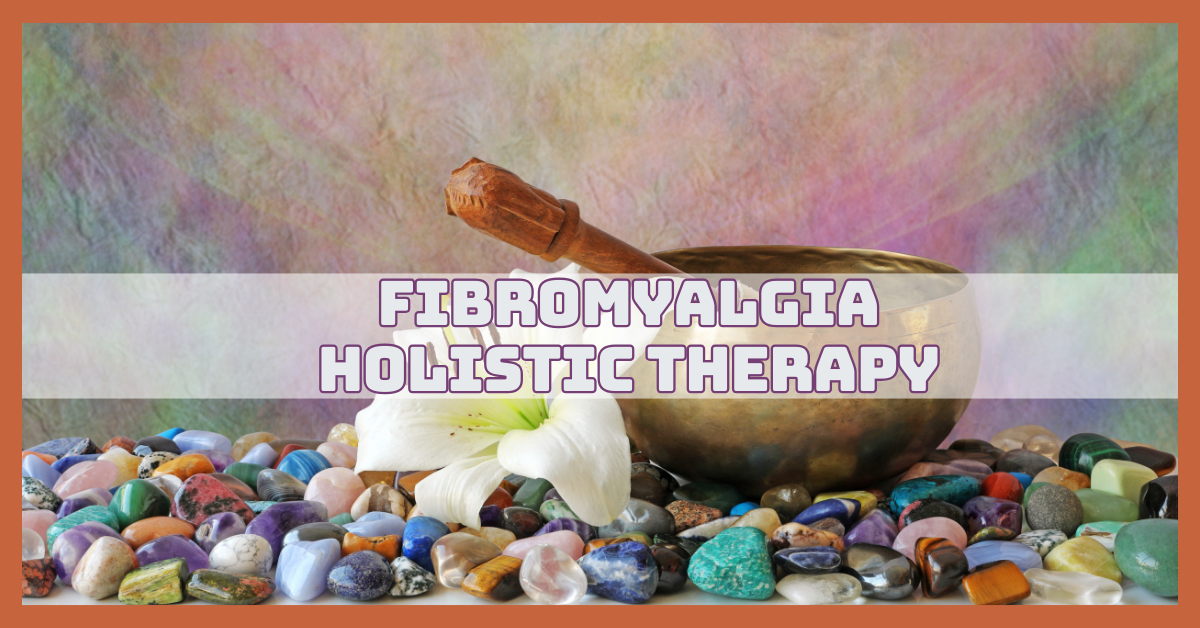Transform Your Life With Fibromyalgia Holistic Therapy
The chronic illness known as fibromyalgia is characterized by persistent pain, exhaustion, and irregular sleep patterns.
Many patients find that Fibromyalgia Holistic Therapy provides a natural, effective way to manage pain, improve energy, and enhance overall well-being.
While medications can help, many people seek holistic therapies for natural relief. These approaches focus on the mind, body, and lifestyle, aiming to reduce pain, boost energy, and improve overall well-being.
This article explores effective natural strategies for living better with fibromyalgia.
What Is Fibromyalgia Holistic Therapy?
Fibromyalgia holistic therapy began gaining recognition in the late 20th century as patients and practitioners sought alternatives to conventional medicine’s limited solutions for chronic pain and fatigue.
While fibromyalgia itself was officially acknowledged by the American College of Rheumatology in 1990, many people turned to holistic approaches earlier, influenced by Eastern practices such as acupuncture, yoga, and Ayurveda, as well as Western traditions of herbal medicine and mind-body healing.
The movement toward holistic care grew in the United States and Europe, particularly during the 1980s and 1990s, when interest in natural and integrative medicine expanded.
These therapies emphasized treating the whole person—body, mind, and spirit—rather than focusing solely on symptoms.
Holistic fibromyalgia treatment combines meditation, massage, diet changes, and energy healing. It aims to reduce discomfort and enhance the quality of life through a patient-centred approach.
Fibromyalgia Holistic Therapy Techniques
Managing fibromyalgia can feel overwhelming. Pain, fatigue, and stress often make daily life challenging. By combining mind-body practices, nutrition, and lifestyle changes, you can regain balance and feel more in control.
1. Meditation And Mindfulness
For the management of fibromyalgia, mindfulness and meditation are easy yet effective techniques. They lessen stress and relax the neurological system, which frequently causes flare-ups of pain.
Mindfulness helps you stay present, so you’re less caught up in discomfort or worry. Even just five minutes a day can make a difference. You might notice a better mood, clearer thinking, and improved sleep over time.
Guided meditation apps or quiet personal sessions work well. Start small, focus on your breath, and gradually build a routine. Consistency is key. With time, these practices can bring both physical relief and mental calm.
2. Yoga And Gentle Stretching
Yoga and gentle stretching are excellent for managing fibromyalgia. Incorporating yoga and gentle stretching is an effective part of fibromyalgia holistic therapy, helping reduce pain, improve flexibility, and support overall well-being.
Even simple poses, like child’s pose or cat-cow, can make a big difference. These movements boost circulation and help your body feel more awake and energized. Practicing just a few times per week can reduce pain and stiffness over time.
The key is to move gently, listen to your body, and avoid overexertion. In addition, yoga promotes better sleep, lowers tension, and relaxes the mind. Small, consistent sessions create lasting physical and mental benefits.
3. Tai Chi
The soft, flowing workout style of tai chi is ideal for people with fibromyalgia. Its slow movements combine physical activity with mindfulness, helping the body and mind work together.
Practicing Tai Chi can ease muscle pain, improve balance, and reduce fatigue. Unlike high-impact workouts, it’s easy on joints and muscles, making it safe for most people.
Regular practice also promotes mental calm, reduces stress, and enhances focus. You don’t need special equipment—just a quiet space and comfortable clothes.
Even short daily sessions can make a noticeable difference. Over time, Tai Chi can help you feel stronger, calmer, and more energized.
4. Nutrition And Anti-Inflammatory Diet
Nutrition plays a huge role in managing fibromyalgia. Eating whole, anti-inflammatory foods helps reduce pain and supports overall health. Essential nutrients and anti-inflammatory foods include leafy greens, berries, nuts, seeds, and fatty fish.
Processed foods, sugar, and common triggers like gluten or dairy can worsen symptoms, so it’s best to limit them. Staying hydrated is equally important—it helps combat fatigue and keeps your body functioning smoothly.
Over time, little regular dietary adjustments can have a significant impact. Paying attention to what you eat empowers you to take control of your health and feel more energized daily.
5. Massage Therapy
Fibromyalgia pain can be effectively and gently managed with massage therapy. Techniques like Swedish or lymphatic massage help release muscle tension and improve blood circulation.
Regular sessions can reduce stiffness, enhance mobility, and promote relaxation. Even short massages at home or using a massage tool provide relief.
The touch also triggers endorphins, natural pain-relievers, and eases stress. Communicating your comfort level with a therapist is essential to avoid overpressure.
Consistent massage therapy not only alleviates physical discomfort but also supports mental well-being, helping you feel calmer, lighter, and more energized in your daily life.
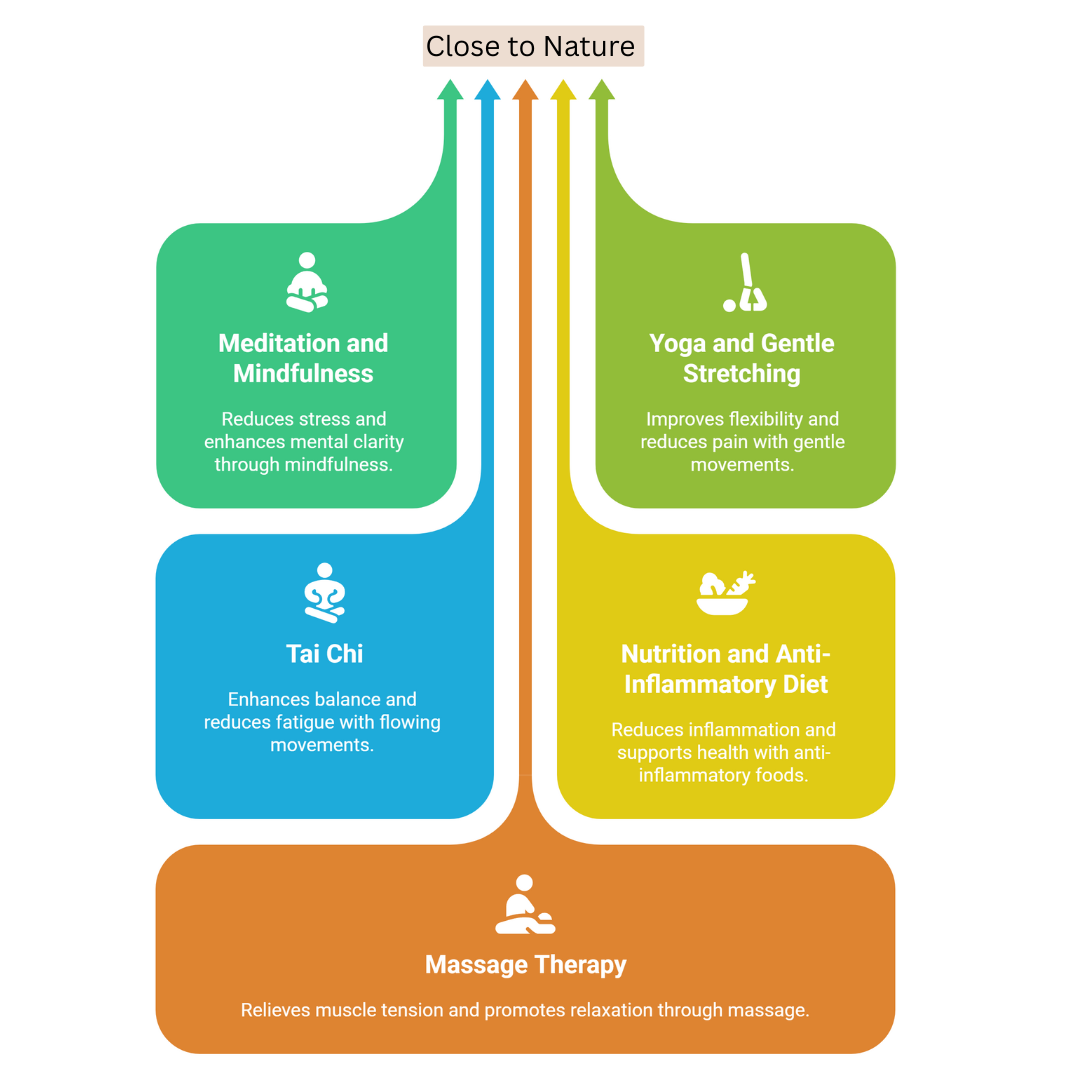
6. Aromatherapy
Aromatherapy is a valuable component of fibromyalgia holistic therapy, helping reduce stress, improve sleep, and enhance overall well-being naturally. Lavender, peppermint, and chamomile are beneficial for fibromyalgia.
A diffuser, warm bath, or gentle massage with diluted oils can create a calming environment. Aromatherapy reduces stress, lowers tension, and helps your mind relax.
Even a few minutes of inhaling soothing scents can boost mood and mental clarity. Always test oils on a small patch of skin to avoid allergies.
Integrating aromatherapy into your routine enhances holistic care, complementing other therapies like meditation, yoga, and massage, for a complete approach to managing symptoms naturally.
7. Low-Impact Exercise
Low-impact exercises are ideal for fibromyalgia, offering benefits without straining joints. Walking, swimming, or cycling strengthens muscles, improves circulation, and boosts stamina.
Gradual, consistent activity helps reduce stiffness and pain over time. Start with brief sessions and gradually extend them to prevent exhaustion. Tracking progress keeps motivation high and shows improvement.
Combining exercise with stretching or yoga enhances flexibility and overall mobility. Energy levels and the management of symptoms might be affected by even minor everyday motions.
Regular low-impact exercise supports physical health, improves mental well-being, and empowers you to stay active despite fibromyalgia challenges.
8. Sleep And Stress Management
Quality sleep and stress control are crucial for managing fibromyalgia. Poor sleep worsens pain, fatigue, and mood. Holistic techniques like guided meditation, deep breathing, journaling, or nature walks help calm the mind and body.
Developing a consistent bedtime routine improves sleep quality. Reducing stress prevents symptom flare-ups and supports emotional resilience.
Even small practices, like limiting screen time before bed or practicing mindfulness, have a significant impact. Managing stress and prioritizing rest creates a stronger foundation for holistic therapies.
Over time, better sleep and stress control help improve energy, mental clarity, and overall quality of life.
9. Cognitive Behavioural Therapy (CBT)
Cognitive Behavioural Therapy is an effective part of fibromyalgia holistic therapy, helping manage pain, reduce stress, and improve overall mental and emotional well-being.
You can use it to recognize negative thought patterns that can exacerbate weariness and discomfort. CBT teaches coping strategies for stress, anxiety, and sleep disturbances.
Working with a therapist experienced in fibromyalgia can improve mental resilience and emotional balance. You’ll learn practical ways to handle flare-ups and daily challenges.
CBT also empowers you to change reactions to pain, reducing its impact on your life. Even practicing small techniques at home, like reframing thoughts or journaling, can gradually improve mood, sleep, and overall well-being.
10. Hydrotherapy
Hydrotherapy uses warm water to relax muscles and ease stiffness. Swimming, gentle water exercises, or soaking in a warm bath can reduce pain while improving circulation.
Water's buoyancy helps to support muscles and joints, which makes moving safer and easier. Regular sessions help decrease tension and promote relaxation, while also encouraging gentle exercise without strain.
Warm water increases blood flow, which aids healing and reduces soreness. Hydrotherapy also has a calming effect on the nervous system, helping with stress and sleep. Even a few minutes daily in a warm bath can significantly boost comfort and mobility.
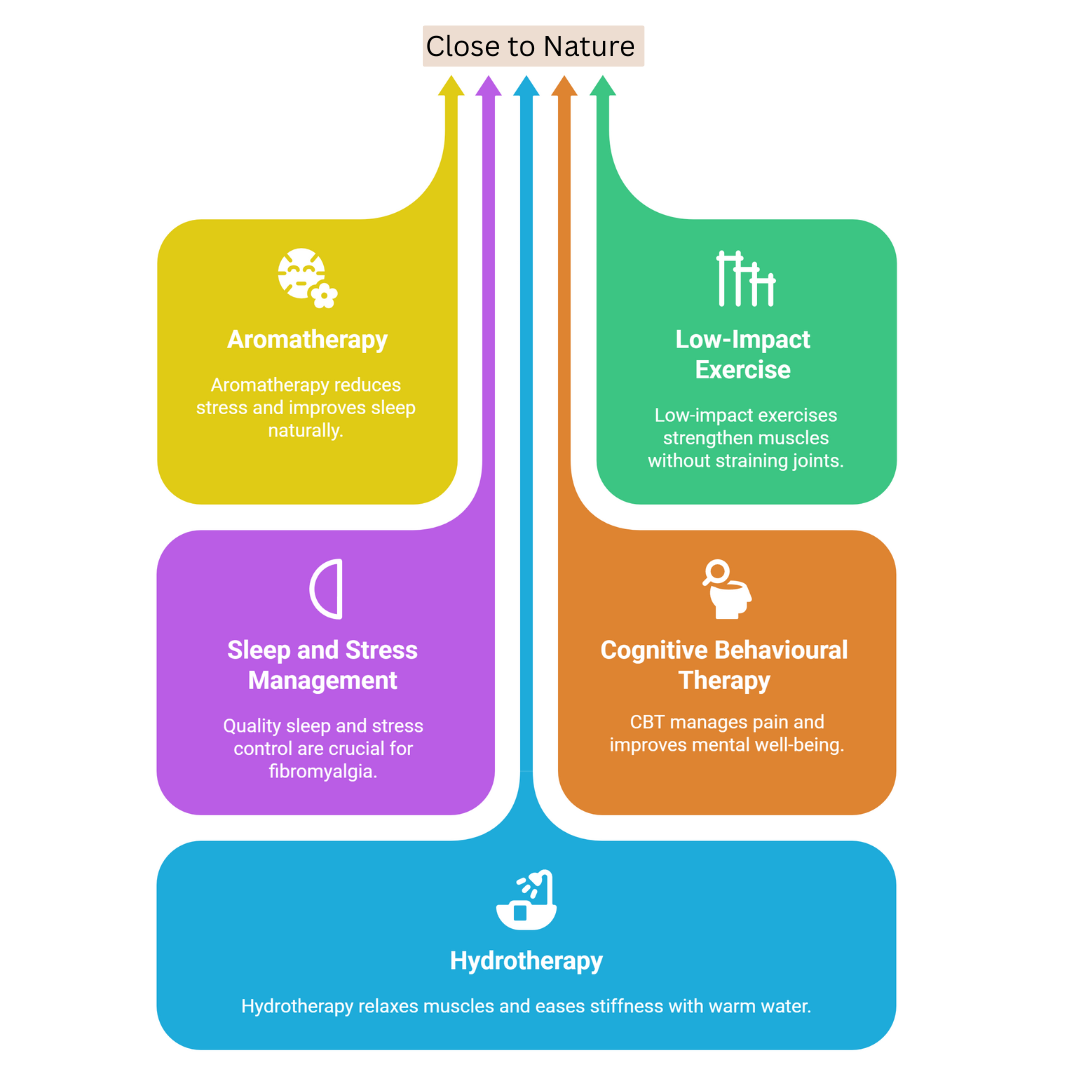
11. Mindful Breathing Exercises
Mindful breathing is simple but highly effective for fibromyalgia. Your body relaxes in response to deep, steady breathing, which eases stress and tense muscles.
Practicing 5–10 minutes daily can improve focus, emotional balance, and overall calm. You can stay in the now and lower your anxiety by using techniques like guided breathing exercises, box breathing, or belly breathing.
Mindful breathing can also enhance meditation or gentle movement practices like yoga or Tai Chi. Over time, it lowers pain perception and supports better sleep.
You can do it anywhere—at home, at work, or even during a flare-up—to bring immediate relaxation and mental clarity.
12. Herbal Supplements
Certain herbs may help ease fibromyalgia symptoms naturally. Turmeric and ginger reduce inflammation, while valerian root can improve sleep quality.
Other options, like chamomile or lavender, may calm stress and promote relaxation. It is always best to consult a healthcare provider before using supplements to ensure the correct dosage and safety.
Herbs can complement diet and lifestyle changes, working alongside other holistic therapies for better symptom management.
Herbal supplements can be a practical addition to fibromyalgia holistic therapy, supporting symptom relief, reducing inflammation, and enhancing overall well-being naturally.
Create a Profitable Holistic Business That Transforms Lives
🌿 Discover inspiring holistic business ideas that blend nature, wellness, and purpose.
Learn how passionate nature lovers are building income streams while helping others live more balanced, mindful lives.
Read Profitable Holistic Business Ideas That Transform Lives
13. Biofeedback
A method called biofeedback trains you to manage your body's reactions to pain and stress. Sensors monitor functions like heart rate or muscle tension, giving real-time feedback.
By observing these signals, you learn how to relax and reduce discomfort. Regular practice helps lower pain intensity, calm the nervous system, and improve emotional regulation.
Biofeedback also enhances mindfulness and self-awareness, giving you practical tools to manage flare-ups. It works best when combined with other holistic therapies, like meditation or gentle exercise.
Over time, biofeedback empowers you to respond to pain more calmly and maintain a greater sense of control in daily life.
14. Energy Healing
Acupuncture and Reiki are examples of energy healing techniques that try to balance the body's energy flow. Many people with fibromyalgia report reduced pain, better sleep, and improved relaxation after sessions.
These therapies help calm the nervous system and promote overall well-being. Energy healing complements other holistic treatments, supporting mind-body balance.
Sessions are generally gentle and non-invasive, making them suitable for most patients. Regular practice may enhance mental clarity and emotional resilience.
While it may not replace conventional care, energy healing offers an additional layer of support for those seeking natural, holistic relief from fibromyalgia symptoms.
15. Journaling And Emotional Expression
Journaling provides an outlet for emotions and stress related to fibromyalgia. Writing about your experiences, triggers, and improvements helps you track symptoms and identify patterns.
It also promotes emotional release, reducing anxiety and mental strain. Daily or weekly journaling encourages mindfulness and self-reflection.
Combining journaling with gratitude lists or goal tracking can boost motivation and mental well-being. Sharing your thoughts with a therapist or support group enhances understanding and support.
Over time, this practice helps you feel more in control, promotes emotional healing, and strengthens your ability to manage pain and fatigue in a positive, proactive way.
16. Aqua Aerobics For Fibromyalgia Relief
Aqua aerobics, or water-based exercise, is an ideal holistic therapy for fibromyalgia patients because water buoyancy reduces joint strain while providing gentle resistance to strengthen muscles.
Exercises typically include water walking or jogging, leg lifts, arm movements, and stretching, all performed in waist-to-chest-deep water.
Classes often combine slow rhythmic movements with light cardio to improve circulation, balance, and flexibility. The warm water helps relax muscles, relieve stiffness, and decrease pain intensity.
For best results, practice 2–3 times per week in a heated pool at a comfortable temperature (around 84–88°F). Aqua aerobics not only enhances physical strength but also promotes relaxation, reduces fatigue, and improves overall mood and sleep quality.
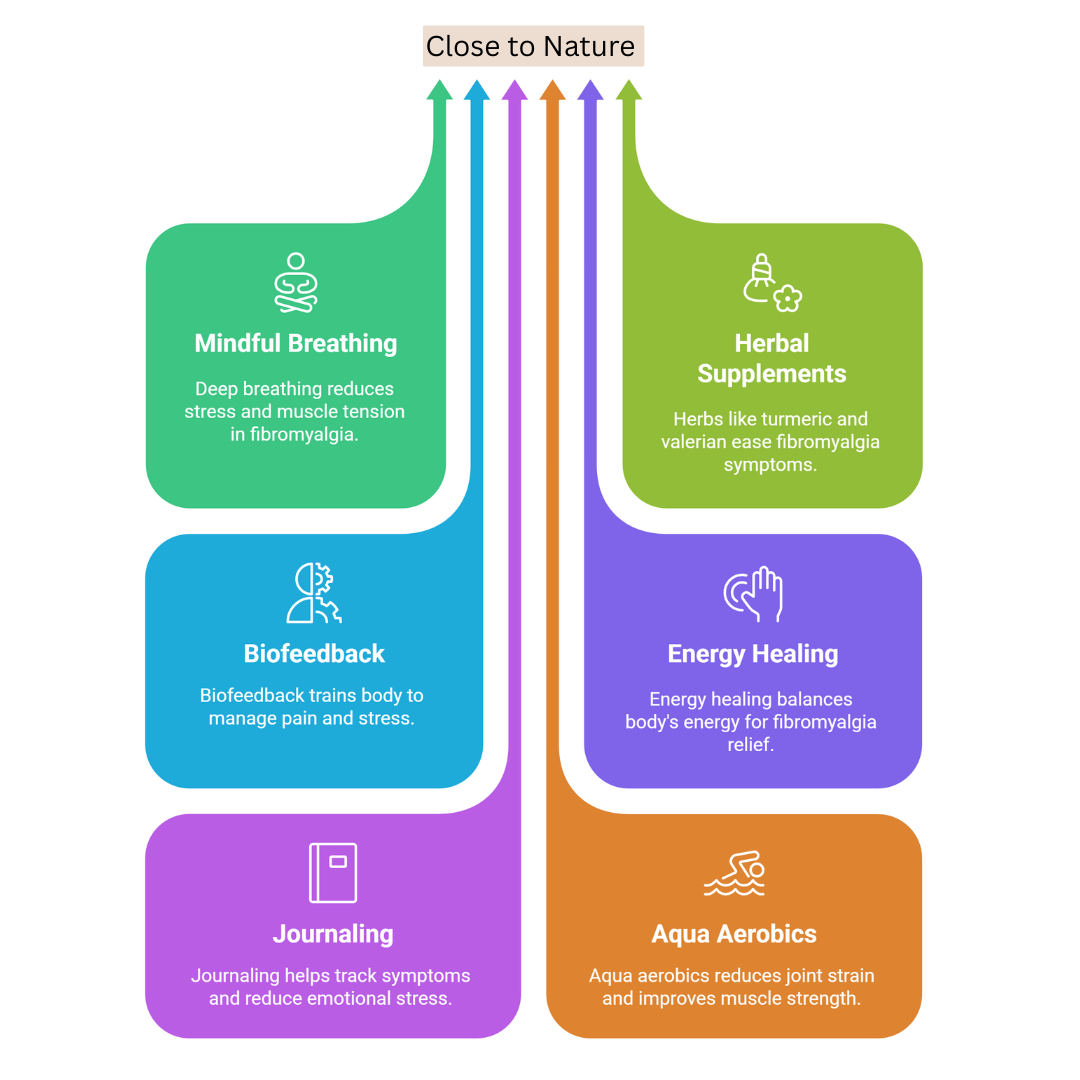
Tips For Successful Fibromyalgia Holistic Therapy
Success with holistic therapy doesn’t happen overnight. Small, consistent steps make the most significant difference. By following simple strategies and listening to your body, you can enhance the benefits of meditation, exercise, nutrition, and other therapies.
These tips help you create a sustainable, effective routine:
1. Listen To Your Body
Your body communicates constantly through pain, fatigue, or stiffness. Don’t push beyond your limits. Rest when needed and adjust activities according to how you feel. Recognizing these signals prevents flare-ups, supports healing, and ensures holistic therapy remains safe and effective.
2. Start Small
Introduce one or two holistic techniques at a time. Trying everything at once can feel overwhelming. Gradually add new practices, like meditation, gentle exercise, or aromatherapy, as your body adjusts. Small, consistent steps lead to lasting improvements and help you develop a sustainable routine.
3. Track Progress
Keep a detailed journal of symptoms, exercise, meals, sleep, and emotional changes. Tracking progress identifies triggers and patterns, helping you adjust your approach.
Documenting improvements reinforces motivation, provides insights for healthcare providers, and makes your holistic therapy plan more personalized and effective.
4. Mix And Match
Combine therapies like mindfulness, yoga, nutrition, massage, and support groups for a synergistic effect. Each technique complements the others, improving physical, mental, and emotional well-being. Flexibility allows you to adapt routines based on energy levels, pain, or daily commitments.
5. Seek Professional Guidance
Before starting new supplements, exercises, or therapies, consult your doctor or a licensed practitioner. Professional guidance ensures safety, avoids harmful interactions, and helps you choose methods suited to your specific symptoms and health conditions.
6. Prioritize Sleep
Prioritizing sleep is a key part of fibromyalgia holistic therapy, helping improve energy, reduce pain, and enhance overall treatment effectiveness.
Develop a bedtime routine, minimize screen time, and create a calm sleep environment. Better sleep improves energy, reduces pain sensitivity, and enhances the effectiveness of holistic therapies.
7. Stay Hydrated
Proper hydration supports muscle function, reduces fatigue, and improves circulation. Throughout the day, drinking water regularly aids in pain management and energy maintenance. Herbal teas or infused water add flavour and additional benefits.
8. Be Patient And Consistent
Holistic therapy requires time to show results. Symptoms may improve gradually. Consistency is key, and even small daily practices accumulate into meaningful benefits over weeks and months. Keep a positive outlook and acknowledge minor victories.
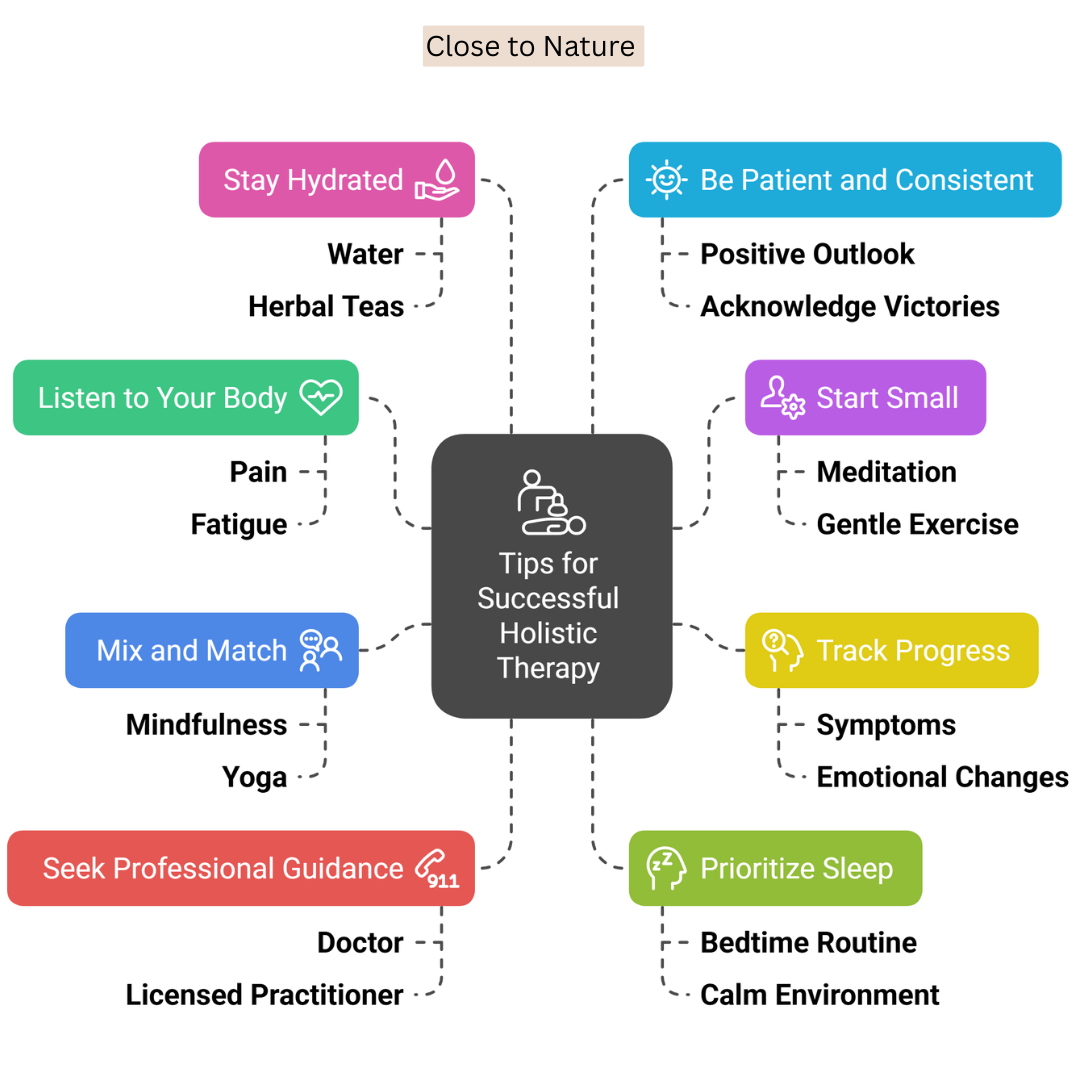
FAQs
1. How Does Holistic Therapy Help With Fibromyalgia?
Holistic therapy addresses multiple aspects of fibromyalgia, including muscle stiffness, sleep disturbances, and emotional stress.
By focusing on lifestyle changes, relaxation techniques, and natural treatments, patients often experience reduced pain, improved sleep quality, and enhanced energy levels.
2. Is It Safe To Combine Holistic Therapy With Conventional Medicine?
Yes, holistic therapy is generally safe and can complement conventional treatments like medication. However, it’s essential to consult your healthcare provider before starting any new therapy to ensure it does not interfere with existing treatments.
3. How Long Does It Take To See Results?
Results vary depending on the individual and the severity of symptoms. Some patients notice improvements in energy and pain levels within a few weeks, while others may take several months of consistent therapy to experience significant relief.
4. Are There Any Side Effects?
Holistic therapies are generally safe, but mild side effects such as temporary muscle soreness after exercise or minor reactions to certain supplements may occur. Always inform your practitioner about any medications or health conditions you have.
Conclusion
Fibromyalgia holistic therapy provides a comprehensive approach to managing pain, improving sleep, boosting energy, and enhancing overall well-being for a more balanced, fulfilling life.
By combining mind-body practices, gentle exercise, nutrition, stress management, and emotional support, you can reduce pain, improve sleep, and boost energy. Consistency and self-care are key.
With patience, awareness, and a personalized approach, holistic therapies empower you to regain control, enhance well-being, and live a more balanced, fulfilling life despite the daily challenges of fibromyalgia.
I trust you enjoyed this article on Transform Your Life With Fibromyalgia Holistic Therapy. Please stay tuned for more inspiring guides, helpful tips, and ideas to help you live closer to nature every day.
Take care!
— JeannetteZ
💬 Your Opinion Is Important To Me
Do you have thoughts, ideas, or questions? I’d love to hear from you. Please leave your comments below or email me directly at Jeannette@Close-To-Nature.org.
📚 More Nature-Inspired Reads
Explore more ways to connect with nature, nurture your pets, and live in harmony with the world around you 🌿

